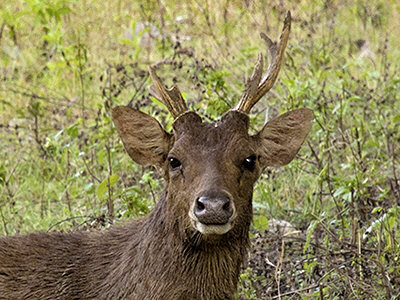
Fig 1

Fig 2

Fig 3
|
Order : CETARTIODACTYLA
Family : Cervidae
Species : Rusa timorensis
Shoulder Height : Males up to
1.1 metres
Tail Length : Males up to 20 cm
Weight : Males up to 115 kg
Females are smaller.
The Javan Rusa (also known
as Timor
Deer or Sunda Sambar) is a native of Indonesia, occurring in a range of habitats
including dry, sun-dappled forest and open savanna or grassland. Typically
these deer graze in open, grassy areas and retreat to the forest shade in the heat of
the day. The species appears able to survive in areas where there is little
fresh water.
The original range of the species is uncertain, as it was
introduced many centuries ago to other parts of Indonesia. Clearly it was a
native of Java and Bali, but it appears disputed as to whether it
occurred naturally in other islands to the east of Bali. Its current range includes, in
addition to Java and Bali, the islands of Sumbawa, Komodo, Rinca, the
Moluccas, Sulawesi, Timor and some lowland areas of New Guinea. The species
has also been introduced to locales as far afield as Australia and New
Zealand.
Despite a complex history of introduction, seven or eight subspecies are
recognised, spread across the Indonesian archipelago.
The species is closely related to the larger Sambar
Rusa unicolor.
Males with antlers can be distinguished from Sambar by the
relative position of the longest tine of the antlers : in the Javan Rusa the
inner tine is the longest, whilst in the Sambar it is the outer tine.
The species is typified by large ears and a medium brown coat, which is
slightly paler on the belly. The young are plain-coloured at birth too,
lacking the spots so typical of other species of deer.
Javan Rusa feed on a range of vegetation including grass, fresh leaves and
fallen fruit.
On the islands of Komodo and Rinca
the species is considered as introduced : it forms an important part of the
prey base of the
Komodo Dragon.
Fig 1 : Male, with antlers in velvet, seeking
forest shade during a hot, sunny afternoon.
Fig 2 : Male with fully developed antlers grazing on cropped grass.
Fig 3 : This male, with broken antlers, clearly lost a fight with a
stronger opponent.
References :
A Natural History Guide to Komodo National Park, Erdmann, A. M.,
2004. The Nature Conservancy.
|